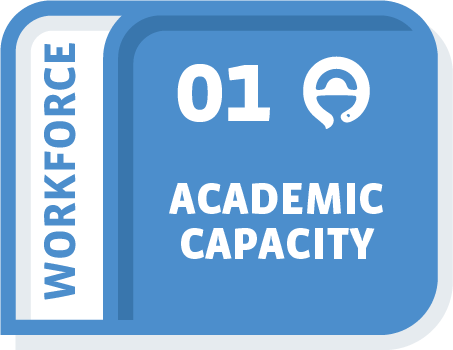Welcome to the Workforce Reference Guide for FIP Development Goal 1 Academic Capacity. This guide collates all information, evidence and expertise from FIP to support our members with measuring progress, evaluation, implementation and transformation processes. To access the full Workforce Reference Guide for the FIP Development Goals, click here.

FIP Development Goal 1 Workforce Element
Globally, we will have:
Engagement with pharmaceutical higher education development policies and ready access to leaders in all sectors of pharmacy practice and pharmaceutical science in order to support supply-side workforce development agendas.
Mechanisms
- Increase the capacity to provide a competent pharmaceutical workforce by developing initial education and training programmes that are fit for purpose, according to national health resource needs (clinical practice, pharmaceutical science areas and stakeholders across all cadres).
- Develop new and innovative ways to attract young pharmacists into all areas of pharmaceutical practice and science (e.g., encourage young pharmacists to consider careers in clinical academia, as preceptors/trainers, in industrial pharmacy, regulatory sciences, nuclear and veterinary pharmacy, among others).
- Capacity building should include the ability to meet minimum national standards of facilities, educators and student support in order to ensure access to quality education for all students.
- Enhance interdisciplinary & interprofessional education and collaboration with key stakeholders, including governments, national and international health & pharmaceutical organisations and patient advocacy groups to achieve sustainable solutions for capacity development.
- The clinical academic educator workforce needs more attention to training, career development and capacity building, which must, importantly, include research capacity enhancement.
- Using data and evidence to support investment in pharmaceutical higher education
View all elements of FIP Development Goal 1 here.
FIP Reports
FIPEd Global Education Report (2013)
FIP Publications
- Anderson C, Brock T, Bates I, et al. Transforming health professional education. Am J Pharm Educ. 2011;75(2):22. doi:10.5688/ajpe75222
- Anderson C. Academic and institutional capacity: a global issue. Am J Pharm Educ. 2008;72(5):114. doi:10.5688/aj7205114
- Rennie T and Anderson C. Oversupply and under-resourced: the global context of pharmacy education. Am J Pharm Educ. 2013, 77 (6) 111; DOI: https://doi.org/10.5688/ajpe776111
- Anderson C, Marriott JL, Carrasqueira J, et al. Turning the world of pharmacy education into a global community through sharing. Am J Pharm Educ. 2014;78(7):130. doi:10.5688/ajpe787130
Related events & training
Remote & online education in trying times: Sharing and learning from each other
Experiential education in trying times: It can be done! Let’s explore how
Remote & online education during COVID-19: “How to” suggestions
Impact of COVID-19 on Pharmacy Education: Perspective from students & academics
MyDispense: A virtual simulation to teach pharmacy students across the globe
Remote Laboratory Courses Across Pharmacy Schools During COVID-19: Are You Ready?
Return to Pharmacy Education: Planning for the Upcoming Academic Year
Workforce Development Hub Global Leads for FIP Development Goal 1
|
Claire Anderson (UK) Professor of Social Pharmacy, Division of Pharmacy Practice and Policy, School of Pharmacy, University of Nottingham, UK.
|
|
|
Shaun Gleason (USA) Director, Distance Degrees and Programs; Associate Professor, Dept. of Clinical Pharmacy, University of Colorado Skaggs School of Pharmacy.
|
|
|
Patricia Acuna-Johnson (Chile) Faculty Member, School of Chemistry and Pharmacy/Faculty of Pharmacy. U. Valparaiso, Chile
|
Find out more about the FIP Workforce Development Hub and our other Global Leads here.
Ongoing projects
- We are developing a tool to support nations assess education development needs – this is based on a tool already developed and piloted in Nigeria.
Bibliography & further reading
- Frenk J, Chen L, Bhutta ZA, et al. Health professionals for a new century transforming education to strengthen health systems in an interdependent world. Lancet. 2010;376(9756): DOI 10.1016/S0140-6736(10)61854-5. http://www.thelancet.com/journals/lancet/article/PIIS0140-6736(10)61854-5/fulltext?_eventId=login
- Claire Anderson and Arijana Mestrovic. Capacity Building in Pharmacy Education chapter in Pharmacy Education in the Twenty First Century and Beyond (1st Ed) Editors: Ahmed Fathelrahman Mohamed Izham Ibrahim Alian Alrasheedy Albert Wertheimer Elsevier, 2018. https://doi.org/10.1016/B978-0-12-811909-9.00014-9
- Chanakit, T., Low, B.Y., Wongpoowarak, P. et al. Does a transition in education equate to a transition in practice? Thai stakeholder’s perceptions of the introduction of the Doctor of Pharmacy programme. BMC Med Educ 15, 205 (2015). https://doi.org/10.1186/s12909-015-0473-4
- Anderson C. Recruiting the Right Students. Am J Pharm Educ. 2017;81(3):42. doi:10.5688/ajpe81342
- Shaw J, Kennedy J, Jensen M, Sheridan J. An international perspective on pharmacy student selection policies and processes. Am J Pharm Educ. 2015;79(8): Article 115.
- Ikhile I, Anderson C, McGrath S, Bridges S. Is the Global Pharmacy Workforce Issue All About Numbers? Am J Pharm Educ. 2018;82(6):6818. doi:10.5688/ajpe6818
- Pharmacy Practice in Developing Countries: Achievements and Challenges. Ahmed Ibrahim Fathelrahman, Mohamed Izham Mohamed Ibrahim & Albert I. Wertheimer, Eds. 2016. Academic Press (Elsevier).
Find out more about the FIP Workforce Reference Guide and explore it fully here.